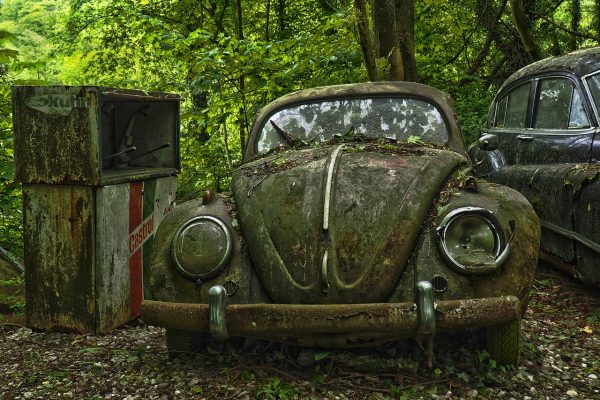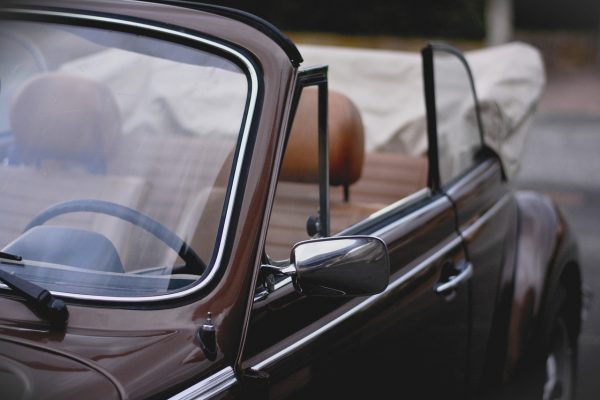The world’s best selling car ever is the VW Beetle. Back in the day they were also known as punch buggies.
The VW Beetle
Some Beetles are more collectible than others. The very early ones have become very rare. The models first commercially produced and exported after World War II had a split rear window (rather like the 1963 Corvette coupe). These are now very rare, and unless you’re lucky enough to find one in the back of a barn somewhere then the only time you’re likely to see one will be at a classic car show on display.
The next model out, which arrived in 1953, had an oval-shaped rear window. There were a lot more of these available for export to the States, so you will be luckier trying to find one of these than a split-window Bug, but believe me they’re still now very rare. In 1957 they changed to a new rectangular rear window.
The “modern” VW Beetle began in 1964 when the windows were enlarged. In 1965 the new 1285-cc, 40-hp Beetle was introduced, to huge sales. It had an all syncho gearbox but its electrical system was still only 6 volts. In 1967 at last came the 12-volt system along with a 1500-cc, 44-hp engine as an option.
You could still buy the 1200-cc or 1300-cc as an alternative to the new 1500-cc. Believe me, you can feel the difference between a 1500-cc and a 1200-cc in acceleration.
But my favorite is still the older 1200cc. Don’t know why, just love them though.
VW Beetles and Speed
No original Beetle is at all fast, by the way. The split window had a 1131 cc 4-cylinder motor with just 25 hp, and that was only marginally increased to 1192 cc and 30 hp for the oval-window VW Beetle.
You can, in fact, get a staggering amount of horsepower out of a Beetle engine with modifications, but now they’re so collectable that if you mess around with things like drive trains or body work you’ll only send the value downhill. If you want a hot-rod Beetle, go buy a later model one that someone has spent a fortune on and now wants to get out of. Surprise your buddies passing their Japanese cars like they’re standing still.
What to Watch for When Buying a VW Beetle
Cosmetic rust on Beetles is easy to see and very repairable. If you know what you’re doing you can do it yourself, or, you may have an older guy around the town that will do a good job for you for a few dollars or some beers.
But there are areas that can be difficult to see and can be causing real damage. The heater channels run along the floorpan on both sides. These can have internal corrosion. You can do patch panels on these but ideally it’s best to remove the whole body from the floorpan. This is actually quite an easy job as the floorpan is simply bolted onto the body with bolts down each side. With a buddy if you have some old mattresses laid out on one side you can just roll the body off and then you can attend to the whole floorpan very easily.
Beetles are also known to rust in the spare wheel well. Although a tricky repair with the body on, it’s not difficult with the body off.
Engines Can Be Rebuilt
Engines on Beetles are pretty reliable and if serviced are good for 300,000 miles before needing a rebuild. But if they do need a rebuild they are remarkably easy to remove and work on. Just four bolts hold them in. So once you’ve supported the engine on a sturdy trolley jack and removed all electrics and carburettor accelerator cable, just undo the four bolts onto the gearbox and slowly slide the motor out on the trolley jack. There’s an incredible number of VW repairers and reconditions around if you don’t want to do it yourself, and even no shortage of exchange motors, but if you go that way and you’ve got a real classic on your hands, you’ll lose the ‘numbers matching’ tag.
Transmission Problems
Gearboxes are rugged and can last forever too. If your Beetle slips out of gear, it could be something as easy as a worn gearbox mounting. The proof of a worn mounting is when the Beetle is driven down the road, watch to see if the exhaust tailpipes move up and down under acceleration. If they do a mounting is a super easy fix.
If the car judders under early acceleration, that will be a clutch plate problem. Once again with the engine out a dead easy repair.
If you do happen to pick up an early 6 volt VW Beetle, you’ll want to convert it to 12 volts straight away. The 6 volt lights are terrible for example, but unless you really do know what you’re doing here get a specialist to do it for you. It’s not just a matter of converting to a 12 volt starter system. And if you do convert, keep every 6 volt piece that was stripped off, because the next owner, for authenticity’s sake, may want to convert it all the way back again.
VW Beetles Are Easy and Fun
So, that’s all about Beetles. Do one or two of these and you’ll get a great sense of enjoyment in that you’re not just flipping a car but keeping a valuable car on the road. You’ll learn a lot doing it and make heaps of contacts for everyone in the motor trade and come across true experts that you can lean a lot from. Before you know it you’ll be graduating to restoring and flipping some great American classics like Mustangs and Camaro’s, but my advice is start with a VW Beetle first. As long as you have rudimentary mechanical knowledge and an interest in cars anyway, you’ll get a real buzz out of buying one to flip.
A lot has been written about the handling of the early VW Beetle. I agree with all the critics. But in 11,000 miles of driving this split-window Beetle I only had one “moment” of this kind, and that was in the first 20 miles. I had rushed into an unfamiliar corner and lifted off the accelerator, and the swing axles just picked themselves up and skipped. The back wheels immediately rose to their toes and the tail of the Beetle shot from under me. I got a hell of a shock but managed to catch it. After that we were good friends. In fact I soon found out I could hustle the car along at surprisingly good speeds. With four friends and their luggage, and the suspension fairly flattened, I found the air-cooled VW sat squarely and handled even better, much to the disquiet of my friends.
It had one strange quirk, though, which was never accurately traced, but which we suspect came from the worn bushings on the entire front end. If you hit a pothole at a particular angle, the whole front end would begin a violent shimmy, and the only way to stop this was to reduce speed, jam on the brakes, and hang onto the steering wheel like grim death.
Volkswagens in those days were a lot more spartan than the last models. The centre of the dashboard simply housed a large speedometer and matching clock, and was flanked by two lidded glove boxes.
Air-cooled VW Beetles never had a fuel gauge until the mid-1960s. Like most owners I carried a graduated stick in the front boot, and you calculated your mileage and dipped as you travelled. But there was a reserve petrol tap.
Even in those days the car had a heater which was in effect hot air from around the exhaust system and engine compartment re-routed into the cabin by levers on the centre tunnel.
I got to truly love my Beetle. In those days Beetles were plentiful and fairly cheap.
It ended up a beach buggy. A friend and I unbolted the body in about an hour, rolled it off the floorpan, and installed the new aluminium body in about another hour. A little bit of wiring and we were ready to go. So a total car transformation in an afternoon. We called up a truck and they took the body to the tip.
What a shame. These days that split-window air-cooled VW Beetle would have been worth about 20 times more than what it was in the ’70s.
World’s best selling car – The VW Beetle
The first part of VW Beetle history was Lord Rootes (Head of Rootes cars – Hillman, Humber, Singer, Sunbeam) for Germany and amid the rubble and ruin of Post War Germany, a British commission that he headed visited the small town of Wolksburg to report on the remains of the air cooled VW factory and the future of the “Peoples Car.” The Commission reported back “The vehicle does not meet the technical requirements of a motor car. As regards performance and design it is quite unattractive to the average motor car buyer. It is too ugly and noisy – a car like this will remain popular for two or three years, if that.” They finally said that the air cooled VW would be completely uneconomic to build commercially.
Famous last words from Lord Rootes.
That the ugly and noisy car which represented the life’s dream of Ferdinand Porsche and a major plank in the political success of Adolf Hitler would rise in VW Beetle history to become the best selling car in the world was then quite unforeseen by even the most ardent air cooled VW supporters and there were not many of those at this time.
The car by 1945 had been an unfulfilled promise for more than a decade as the result of developmental problems., obstacles planted by other German manufacturers jealous and worried about the Government backed interloper, and of course the war.
About 336,000 Volkswagen savers – workers who had lay-byed their future cars at the rate of about five Marks a week before 1939 – had seen their 267 million Mark deposits, scooped up by the Russians as they took Berlin, and with that money went many hopes.
A trendsetter it certainly was. Taken back to its first principles, the first Volksauto designed and conceived by the brilliant Ferdinand Porsche was a direct development of the theme which created the World’s first really successful rear engined racing car, the 545 hp Auto Union which together with Mercedes dominated European racing in the last five years of the 1930s.
Although initially produced in many variations by Porsche’s Stuttgart industrial design firm to suit a number of potential customers. Ferdinand’s dream car for the masses always had the same basic theme, that of a small, aerodynamic sedan with an engine behind the rear axle, and all independent suspension.
Revolutionary ideas indeed in Germany in early VW Beetle history of the late 1920s and early 1930s. It was an unacceptable format to the big German manufacturers who still believed a car should be a luxury.
Porsche’s first thoughts of a people’s car developed soon after WW1, fell on deaf ears for more than a decade before Hitler gave the project the go ahead for the financial incentive that it demanded. The new German Chancellor surprised the German motor industry with his speech in opening the 1933 Berlin Motor Show.
A nation, Hitler said, was no longer judged by other nations by its miles of railroad track but by its miles of paved highways. He called on the manufacturers to bring prestige to Germany on the motor racing circuits and finally requested them to develop a cheap small car for the masses. On this last matter he was very serious, and as a motoring enthusiast himself and a great fan of Henry Ford he regarded the American car ownership to population ratio with some envy.
The legend goes in early VW Beetle history that Porsche first met Hitler when obtaining a subsidy for Auto Union to challenge Mercedes in motor racing. The result was the 16 cylinder Auto Union race car but that was less important than the introduction it gave Porsche to the air cooled VW
Porsche and Hitler
The following year, in early VW Beetle history, Hitler learnt of Porsche’s small car plans and disgusted with the apathy which the German manufacturers had greeted his ‘people car’ request, offered the job to the Czech master designer to design the air cooled VW.
He listened with great interest to Porsche’s plans but insisted it be more economical and knocked 650 Marks off the estimated cost price. The German Automobile Industry Association was to coordinate the building of the car but because of great internal jealousy in the industry, there were immediate delays. Nevertheless by the end of 1938 three prototypes were running and the following year Mercedes built another 30 cars for testing.
These unusual hump backed cars had no back window at all, a low smooth sloping front and were powered by a four cylinder engine of one litre capacity with two banks of horizontally opposed cylinders. It was very much the forerunner of the air cooled VW Beetle.
That year Hitler grew impatient with the stalling of the rival manufacturers and a company was established to produce the Peoples Car. To raise the necessary funds, the German Labour Front Organisation, the KdF – Kraft-durch-Freude or Strength Through Joy – was called in. An ingenuous five Marks a week layaway scheme was devised and announced in late 1938. Workers were encouraged to lay by one of the new cars which had been labeled the KdF Wagen – Strength through Joy Wagen – By Hitler. A factory town was established near Hanover to produce the air cooled VW.
In early VW Beetle history, the original price had risen from 900 to 990 Marks and there were promises of 1,500,000 cars being assembled annually in the near future. At the five Marks weekly rate it would take a saver four years and seven months to meet the planned purchase price. In return the saver was promised a document of ownership. There was nothing about actually getting a car and there was no guarantee of a fixed price and no warranty was offered. However, 336,668 Germans eventually put aside 267 million Marks and it appears Hitler intended the scheme to work as the money was rifled from a special bank account by the Russians in 1945.
None of the savers ever got a car and it was not until 1961 that a VW Savers lawsuit was finally ended with a mutual settlement being reached. It was not until the late 1940s that the first Volkswagens managed to find their way into the hands of the private workers it was designed for. The early VW Beetle history pre war production cars went immediately to Hitler’s staff while during the war the factory produced the odd looking but very effective military Kubel-wagen and its amphibious brother the Schwimmkubel. Immediate post war production was used by the Germans and their British overlords as barter materials to obtain the steel and machinery necessary to restore the badly damaged plant at Wolsburg. The air cooled VW, Volkswagen’s rise to fame since WW11 is now well known.
View source: Flipping Classic VW Beetle Cars for a Living






